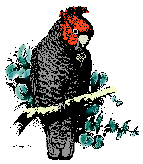 |
canberrabirds
|
 |
canberrabirds
|
| To: | Margaret Leggoe <> |
|---|---|
| Subject: | Question on New Holland Honeyeater |
| From: | Denis Wilson <> |
| Date: | Sat, 29 Jun 2013 12:40:33 +1000 |
|
Yes, it is pollen, as Philip has guessed. The collection of pollen is very important as far as the plants are concerned, as that is how the bird acts as a vector for transferring pollen from one plant to another. Interestingly Rosellas have bypassed the pollination function with the local Waratahs here in the Southern Highlands, by chewing off the entire individual floral tube. Thus preventing pollination of the target flowers. That is a very negative result for the plants. If you are interested, I have photographic evidence on my blog: http://peonyden.blogspot.com.au/2011/10/its-springtime-in-kangaloon.html Denis Wilson Thou shall not steal from future generations by impoverishing or poisoning the Earth. "The Nature of Robertson" www.peonyden.blogspot.com.au On Fri, Jun 28, 2013 at 10:50 PM, Margaret Leggoe <> wrote:
|
| <Prev in Thread] | Current Thread | [Next in Thread> |
|---|---|---|
| ||
| Previous by Date: | signs of spring (well, pre-), Suzanne Edgar |
|---|---|
| Next by Date: | ANBG today, John Leonard |
| Previous by Thread: | Question on New Holland Honeyeater, Margaret Leggoe |
| Next by Thread: | 7:30 Report, Philip Veerman |
| Indexes: | [Date] [Thread] [Top] [All Lists] |
The University of NSW School of Computer and Engineering takes no responsibility for the contents of this archive. It is purely a compilation of material sent by many people to the Canberra Ornithologists Group mailing list. It has not been checked for accuracy nor its content verified in any way. If you wish to get material removed from the archive or have other queries about the list contact David McDonald, list manager, phone (02) 6231 8904 or email . If you can not contact David McDonald e-mail Andrew Taylor at this address: andrewt@cse.unsw.EDU.AU